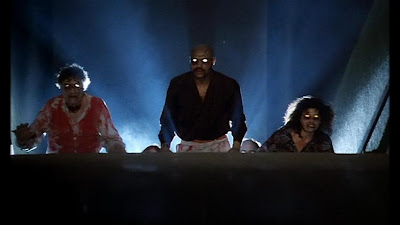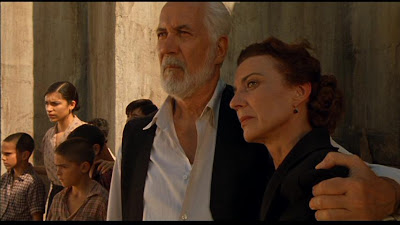Dead of Night (1945)
Two decades before Amicus ushered in the era of the portmanteau horror film, Ealing
studios produced this wonderful anthology of five creepy stories. In the framing narrative, an architect visits
a country home, and encounters five individuals that are manifestations of his
dreams. Fans of The Twilight Zone will instantly recognize similarities between the
TV series’ episode “Twenty Two” and the first segment, titled “Hearse Driver.” In fact, both stemmed from the same E.F.
Benson tale. The weakest segment of the
bunch, concerning a bet between two golfers, strikes a more whimsical tone,
which seems out of step with the other stories.
The filmmakers saved the best for last, however, with “The Ventriloquist’s
Dummy,” (directed by Alberto Cavalcanti).
Is it the man who controls the dummy, or vice versa? It’s a chilling excursion into madness that
has been copied countless times since, but rarely to such great effect. Not currently available through Netflix, it’s
well worth a look if you can find it.
Rating: ****.
Available on DVD and Amazon Instant Video
Stake Land (2010) Director/co-writer
Jim Mickle’s bleak, engrossing post-apocalyptic vampire story recalls I Am Legend and The Road. The film follows
Mister (played by co-writer Nick Damici) and his young protégé Martin (Connor
Paolo) as they make their way north across a plague-ravaged United States,
towards a semi-mythical place known as New Eden. The vampires are decidedly animalistic and
savage, in stark contrast to the more benign variety found in a certain popular
series of films. Vampires are not the
only terrors that they face along the road, however, as they contend with bands
of religious zealots and cannibals. Stake
Land is more than a bit derivative (It’s a little too easy to play spot-the-reference),
but it possesses its own unique energy.
Stake Land was never given a proper theatrical release, and was
unceremoniously released to home video, but it deserved better. I suspect that the distributors considered it
too downbeat for mainstream audiences weaned on sparkly or erudite vampires,
but for those who prefer darkness over fluff, it’s a welcome respite.
Rating: ****.
Available on DVD and Blu-ray

The Church (1989)
(aka: La Chiesa) This curiosity from
Director Michele Soavi (Cemetery Man)
about a gothic cathedral with a dirty little secret never fails to entertain,
even when it’s not making sense (which is most of the time). In the prologue, set during the dark ages, the
denizens of an entire village are accused of witchcraft by a group of Knights
Templar, and summarily sentenced to death.
A huge cathedral is built atop
their buried remains, presumably sealing the evil within. About midway through the film, when a modern-day
interloper unleashes the ancient evil, it runs completely off the rails. The second half of the film contains more
random dialogue and craziness per minute than ten other movies. We’re introduced to one of the strangest
assortments of characters assembled under one roof, including a group of
schoolchildren, a crotchety old man and his amorous wife, and a narcissistic
bride. It must be seen to be believed.
Rating: ***.
Available on DVD
Castle Freak
(1995) This mediocre direct-to-video effort from director/co-writer Stuart
Gordon stars Gordon stalwarts Jeffrey Combs and Barbara Crampton as husband and
wife, John and Susan Reilly. In a
flashback sequence, we witness the automobile accident that claimed the life of
their young son, and blinded their daughter.
When John inherits an Italian castle, he moves with his family to start
a new life, but Susan is unable to forgive him for the accident. To complicate matters, the castle is not
quite as empty as it initially appeared.
With shades of Edgar Allan Poe, and its themes of guilt and family
secrets, Castle Freak has its moments. Considering the low budget origins, the
titular freak makeup is also quite good.
Unfortunately, it’s never particularly scary, and its deadpan tone lacks
the sardonic wit found in Gordon’s better films (such as Re-Animator
and From Beyond). While the film is probably better than most
of the fare that falls under the Full Moon Entertainment banner, that’s not
really saying much.
Rating: ** ½.
Available on DVD
Red Eye (2005)
(aka: Redeu-ai) What could have been
a truly unique and thrilling horror film becomes a confusing mess from director
Dong-bin Kim. Red Eye (not to be confused with the Wes Craven film from the same
year) takes place on a train during its last run from Seoul to the coast. Some of the train cars were salvaged from a
deadly train accident that occurred years before, resulting in the current bout
of ghostly incidents. Oh Mi-sun (Shin-yeong
Jang), on her first trip as an attendant, is inextricably linked to the train’s
past and present. Red Eye isn’t very scary, and it’s hard to tell what’s going on
from one scene to the next. Another nitpick: Modern movie soundtracks can
sometimes overwhelm the dialogue, but in this case, the telltale click-clack
sound of the wheels on the tracks was noticeably absent. While I was willing to forgive many of the
aforementioned trespasses, to a point, Red
Eye’s biggest offense is that it’s often boring. Maybe it should have been called Shut Eye, instead.
Rating: **.
Available on DVD
Dark Tower (1987) Okay,
this one hurt. I heard nothing about
this film before it became available for viewing through Netflix Instant, and now
I know why. Dark Tower was directed by Freddie Francis (his last feature film),
who replaced the original director, Ken Wiederhorn. The presence of Jenny Agutter, Michael
Moriarty and Kevin McCarthy (in a brief, thankless role) does nothing to
mitigate the pain of watching this snoozefest about a haunted high-rise
building in Barcelona. We’re treated to
interminable scenes of workaholic architect Carolyn Page (Agutter) sitting at
her desk, and American detective Dennis Randall (Moriarty) looking befuddled. What’s causing the deaths of people who enter
the building? Will Dennis and Carolyn strike
up a romantic relationship that’s hinted at throughout the film? Why Barcelona? Who knows?
I kept waiting for more to happen, and was consistently disappointed. If you manage to stay awake long enough to
witness the smidgen of action at the conclusion, you’ll be rewarded (I’m using
the term loosely) with a lame twist ending. Don’t bother.
Rating: * ½.
Available on Netflix Streaming


























